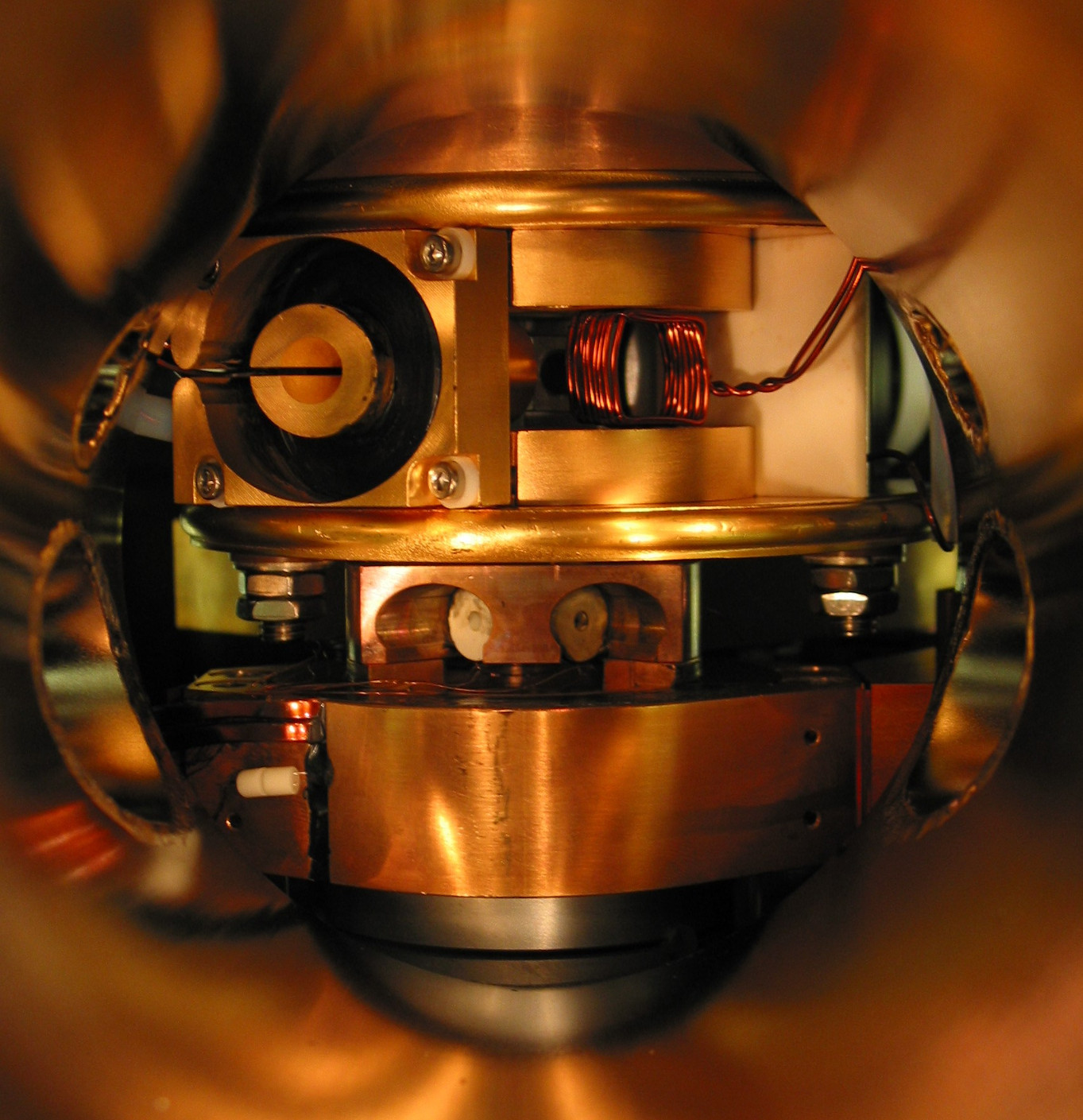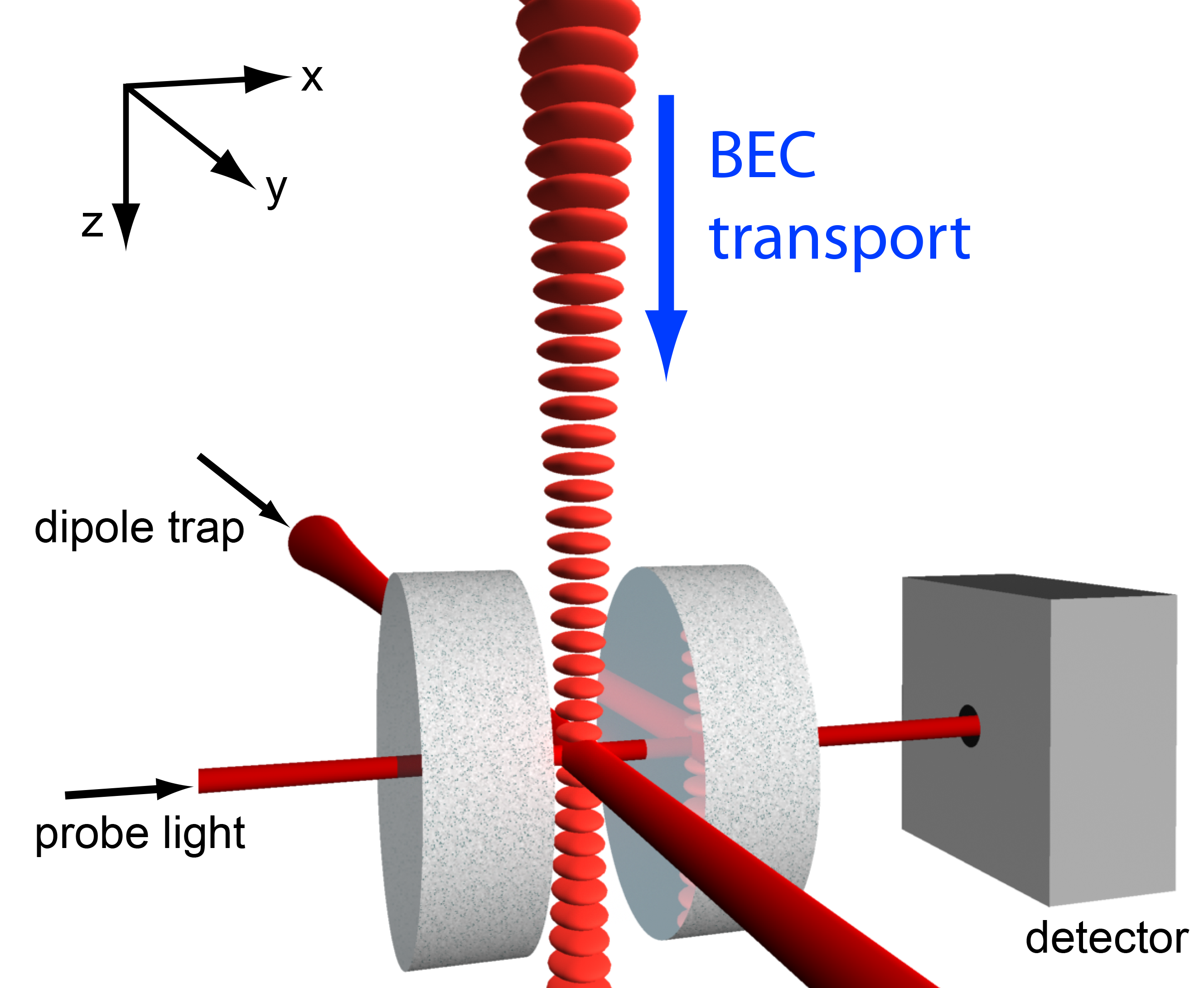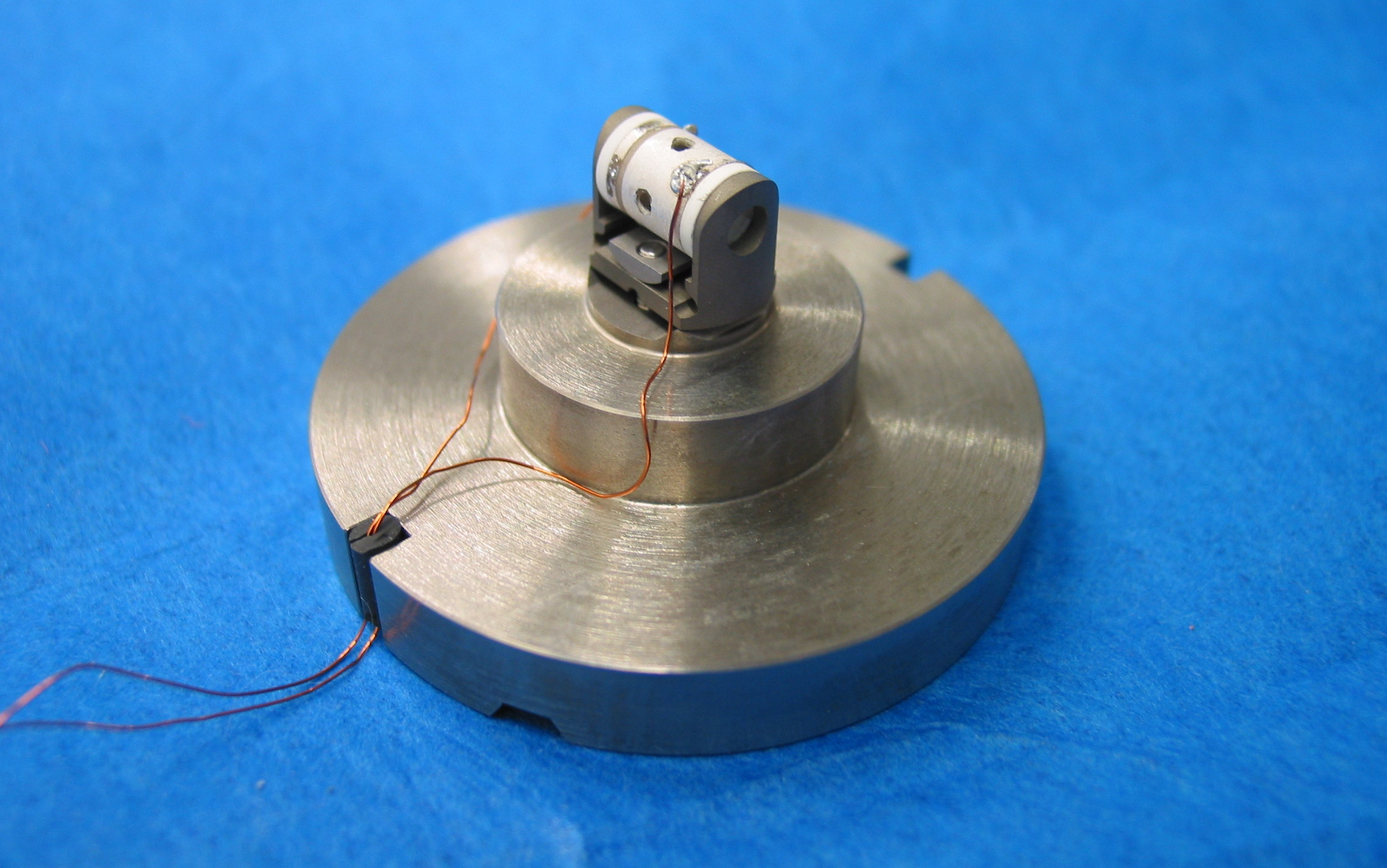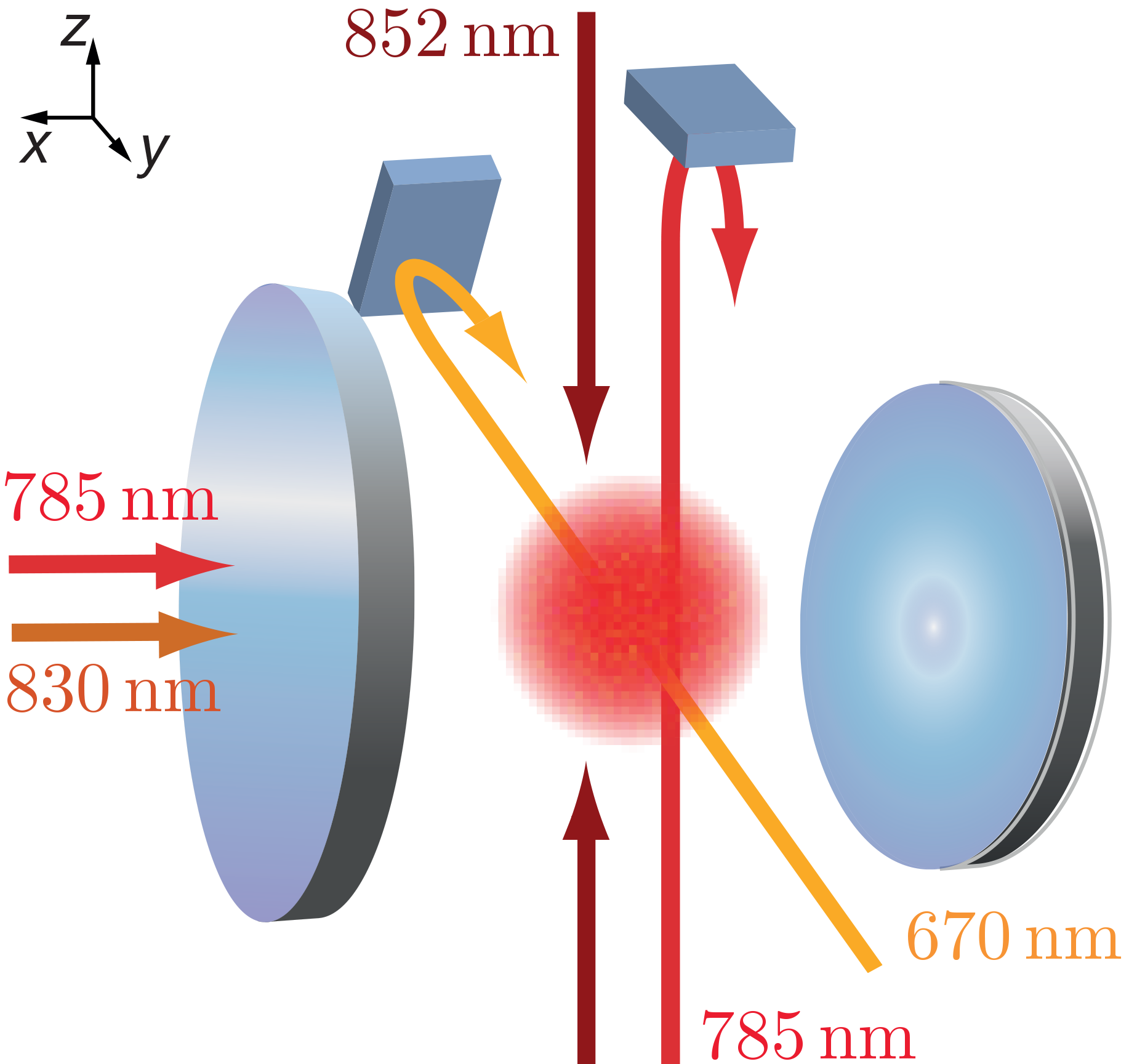Experimental Apparatus
Preparation of an ultracold Rubidium cloud
 The design of our apparatus features two nested vacuum chambers
which are connected by an in vacuo magnetic transport configuration.
After a first magneto-optical trap (MOT) stage in the prechamber, cold
Rubidium-87 atoms are captured in a magnetic quadrupole trap and
transported into the ultra-high vacuum (UHV) chamber. In the UHV
chamber, the atoms are loaded into a magnetic quadrupole-Ioffe trap
(QUIC) where they are cooled close to quantum degeneracy using a
radio-frequency based evaporative cooling technique.
The design of our apparatus features two nested vacuum chambers
which are connected by an in vacuo magnetic transport configuration.
After a first magneto-optical trap (MOT) stage in the prechamber, cold
Rubidium-87 atoms are captured in a magnetic quadrupole trap and
transported into the ultra-high vacuum (UHV) chamber. In the UHV
chamber, the atoms are loaded into a magnetic quadrupole-Ioffe trap
(QUIC) where they are cooled close to quantum degeneracy using a
radio-frequency based evaporative cooling technique.
Optical transport
 Our research focuses on the novel states of matter that can be
prepared by the interaction of a Bose-Einstein condensate (BEC) with
the quantized light field of an optical cavity. The cavity is placed 3.6
cm below the QUIC trap. To transport the ultracold atoms in a
controlled way into the cavity, we implemented an optical conveyor
belt formed by two counter-propagating, red-detuned laser beams
(852 nm). Thanks to the optical dipole force, atoms are loaded into
the antinodes of the vertically aligned standing-wave potential.
Applying a frequency difference between the upwards and the
downwards propagating wave, the optical standing-wave pattern is
brought into motion. Once the atoms have reached the position of
the cavity mode, they are loaded into a crossed-beam dipole trap, where they are further cooled to
quantum degeneracy.
Our research focuses on the novel states of matter that can be
prepared by the interaction of a Bose-Einstein condensate (BEC) with
the quantized light field of an optical cavity. The cavity is placed 3.6
cm below the QUIC trap. To transport the ultracold atoms in a
controlled way into the cavity, we implemented an optical conveyor
belt formed by two counter-propagating, red-detuned laser beams
(852 nm). Thanks to the optical dipole force, atoms are loaded into
the antinodes of the vertically aligned standing-wave potential.
Applying a frequency difference between the upwards and the
downwards propagating wave, the optical standing-wave pattern is
brought into motion. Once the atoms have reached the position of
the cavity mode, they are loaded into a crossed-beam dipole trap, where they are further cooled to
quantum degeneracy.
The high-finesse optical cavity
 The heart of our experiment is given by an optical Fabry-Perot cavity
which consists of two highly reflecting mirrors facing each other at a
distance of only 180 microns. With a finesse of 3.4x105 at 780 nm, light
travels about 105 times between the mirrors before it gets lost through
on of the mirrors. The small cavity mode volume allows us to reach the
single-atom strong coupling regime of cavity QED. The resonant
interaction between the atoms and the cavity, as well as the dispersive
limit of CQED have been explored in our experiments.
The heart of our experiment is given by an optical Fabry-Perot cavity
which consists of two highly reflecting mirrors facing each other at a
distance of only 180 microns. With a finesse of 3.4x105 at 780 nm, light
travels about 105 times between the mirrors before it gets lost through
on of the mirrors. The small cavity mode volume allows us to reach the
single-atom strong coupling regime of cavity QED. The resonant
interaction between the atoms and the cavity, as well as the dispersive
limit of CQED have been explored in our experiments.
Pumping beam and 3D intra-cavity lattice
 Our recent experiments make use of a retro-reflected laser beam at
785 nm, oriented orthogonally to the cavity axes and red-detuned
from atomic resonance. This transverse pump beam induces and
enhances cavity-mediated long-range interactions between the atoms
and also generates an optical lattice along the z direction. In some of
our experiments, a 3D optical lattice was created by intersecting the z
transverse pump, a red-detuned cavity standing wave along x and a
blue-detuned (670 nm) lattice along y. This configuration allowed
exploring a Bose-Hubbard system enriched with cavity-mediated long-range interactions.
Our recent experiments make use of a retro-reflected laser beam at
785 nm, oriented orthogonally to the cavity axes and red-detuned
from atomic resonance. This transverse pump beam induces and
enhances cavity-mediated long-range interactions between the atoms
and also generates an optical lattice along the z direction. In some of
our experiments, a 3D optical lattice was created by intersecting the z
transverse pump, a red-detuned cavity standing wave along x and a
blue-detuned (670 nm) lattice along y. This configuration allowed
exploring a Bose-Hubbard system enriched with cavity-mediated long-range interactions.
Detection methods
We acquire information about the state of the system via two different techniques that are used in
parallel. The first is time-of-flight imaging of the atomic ensemble, which gives direct access to the
momentum distribution of the atoms. In addition to this more usual method, we utilize the light field
leaking from the cavity as a versatile probe for nondestructively monitoring the state of the system. We
detect the cavity output light by using either a single-photon counter or a heterodyne setup. The latter
provides access not only to the amplitude and phase of the cavity field, but also to its frequency
spectrum.
 Our research focuses on the novel states of matter that can be
prepared by the interaction of a Bose-Einstein condensate (BEC) with
the quantized light field of an optical cavity. The cavity is placed 3.6
cm below the QUIC trap. To transport the ultracold atoms in a
controlled way into the cavity, we implemented an optical conveyor
belt formed by two counter-propagating, red-detuned laser beams
(852 nm). Thanks to the optical dipole force, atoms are loaded into
the antinodes of the vertically aligned standing-wave potential.
Applying a frequency difference between the upwards and the
downwards propagating wave, the optical standing-wave pattern is
brought into motion. Once the atoms have reached the position of
the cavity mode, they are loaded into a crossed-beam dipole trap, where they are further cooled to
quantum degeneracy.
Our research focuses on the novel states of matter that can be
prepared by the interaction of a Bose-Einstein condensate (BEC) with
the quantized light field of an optical cavity. The cavity is placed 3.6
cm below the QUIC trap. To transport the ultracold atoms in a
controlled way into the cavity, we implemented an optical conveyor
belt formed by two counter-propagating, red-detuned laser beams
(852 nm). Thanks to the optical dipole force, atoms are loaded into
the antinodes of the vertically aligned standing-wave potential.
Applying a frequency difference between the upwards and the
downwards propagating wave, the optical standing-wave pattern is
brought into motion. Once the atoms have reached the position of
the cavity mode, they are loaded into a crossed-beam dipole trap, where they are further cooled to
quantum degeneracy. Our recent experiments make use of a retro-reflected laser beam at
785 nm, oriented orthogonally to the cavity axes and red-detuned
from atomic resonance. This transverse pump beam induces and
enhances cavity-mediated long-range interactions between the atoms
and also generates an optical lattice along the z direction. In some of
our experiments, a 3D optical lattice was created by intersecting the z
transverse pump, a red-detuned cavity standing wave along x and a
blue-detuned (670 nm) lattice along y. This configuration allowed
exploring a Bose-Hubbard system enriched with cavity-mediated long-range interactions.
Our recent experiments make use of a retro-reflected laser beam at
785 nm, oriented orthogonally to the cavity axes and red-detuned
from atomic resonance. This transverse pump beam induces and
enhances cavity-mediated long-range interactions between the atoms
and also generates an optical lattice along the z direction. In some of
our experiments, a 3D optical lattice was created by intersecting the z
transverse pump, a red-detuned cavity standing wave along x and a
blue-detuned (670 nm) lattice along y. This configuration allowed
exploring a Bose-Hubbard system enriched with cavity-mediated long-range interactions.